Ontario Economic Accounts
Learn about Ontario's economic performance and outlook for the second quarter of 2025.
View the related data tables at Ontario's Open Data Catalogue.
Highlights
- Ontario’s real gross domestic product (GDP) declined 0.6% in the second quarter (April, May, June) of 2025, following a 0.6% increase in the previous quarter.
- The second quarter decline was driven by lower exports and a decline in machinery and equipment investment.
- Nominal GDP decreased 0.4%, following a 1.2% increase in the previous quarter.
- Economy-wide prices, as measured by the implicit price index for GDP, increased 0.3% in the second quarter.
- Economic production, measured on an industry basis, declined 0.3% in the second quarter, as lower goods sector output (−1.4%) was partially offset by higher service sector production (+0.1%).
| Component | 2023 | 2024 | 2024 Q3 | 2024 Q4 | 2025 Q1 | 2025 Q2 |
|---|---|---|---|---|---|---|
| Real GDP | 1.7 | 1.4 | 0.4 | 0.6 | 0.6 | (0.6) |
| Nominal GDP | 5.4 | 5.3 | 1.2 | 1.5 | 1.2 | (0.4) |
Sources: Statistics Canada and Ontario Ministry of Finance.
Expenditure details
Ontario’s real GDP declined 0.6% in the second quarter of 2025, following a 0.6% increase in the first quarter.
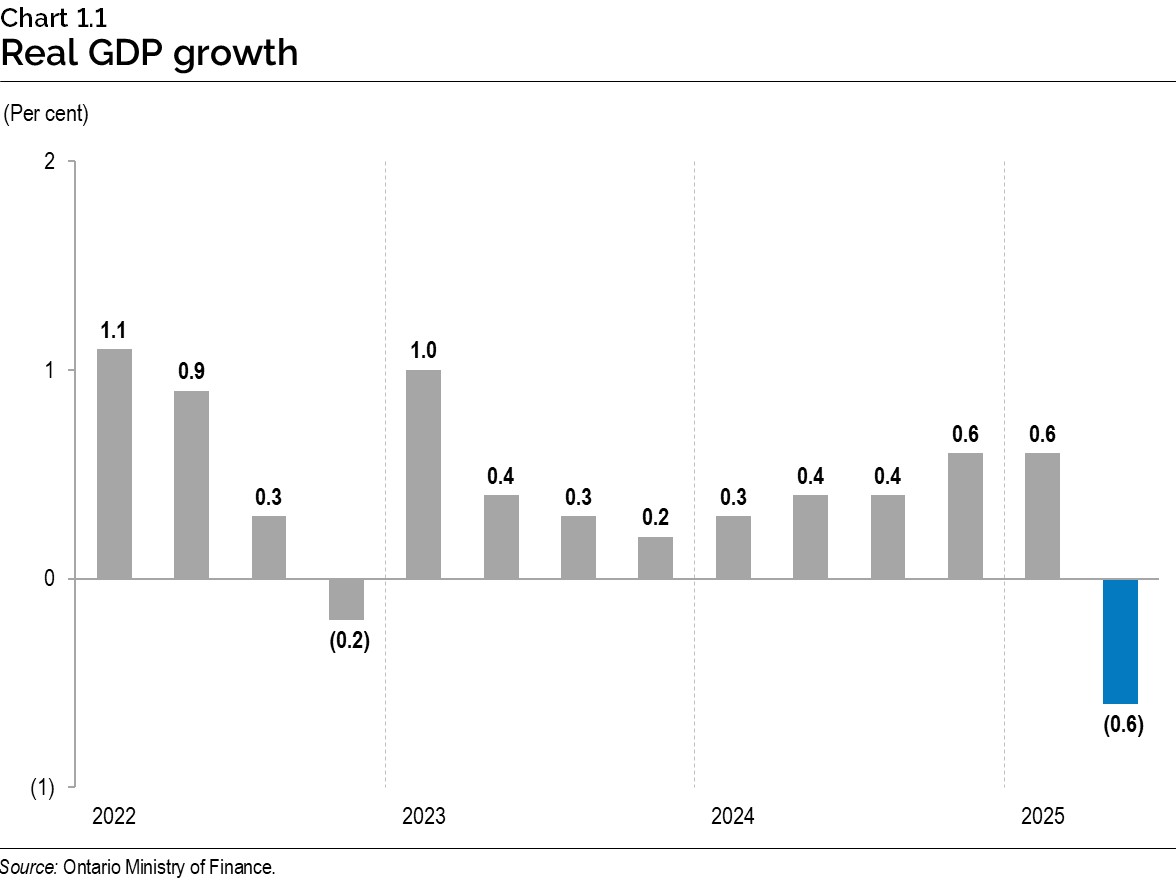
Household consumption spending rose 0.6%, following a 0.3% increase in the previous quarter. Higher spending on durables (+1.4%), semi-durables (+0.2%) and services (+0.8%) was partially offset by lower spending on non-durables (−0.5%).
Total business investment declined 0.8%, following a 0.9% decrease in the previous quarter. Investment in machinery and equipment (−9.8%) and intellectual property products (‑0.2%) declined, while investment was higher for residential (+1.7%) and non-residential (+1.0%) construction.
Spending at all three levels of government combined rose 1.4% in the second quarter, after declining 0.2% in the previous quarter.
Exports (−5.8%) and imports (−1.0%) declined in the second quarter. International exports decreased 7.4%, while international imports were 1.7% lower. Interprovincial exports (−2.2%) declined, while interprovincial imports (+1.1%) increased in the quarter.
Businesses accumulated inventories of $12.4 billion in the second quarter, following an accumulation of $766 million in the previous quarter.
| Component | 2023 | 2024 | 2024 Q3 | 2024 Q4 | 2025 Q1 | 2025 Q2 |
|---|---|---|---|---|---|---|
| Real GDP | 1.7 | 1.4 | 0.4 | 0.6 | 0.6 | (0.6) |
| Household consumption | 1.5 | 2.1 | 0.4 | 1.6 | 0.3 | 0.6 |
| Business investment | (2.1) | (0.3) | (0.5) | 2.2 | (0.9) | (0.8) |
| Government | 1.2 | 3.1 | 1.4 | 0.7 | (0.2) | 1.4 |
| Exports | 4.4 | (1.1) | (0.4) | 1.8 | 2.0 | (5.8) |
| Imports | 0.7 | (1.3) | (0.7) | 0.4 | 1.0 | (1.0) |
| Investment in inventories ($ billions) | 8.7 | 7.7 | 11.9 | (2.2) | 0.8 | 12.4 |
Sources: Statistics Canada and Ontario Ministry of Finance.
Income details
Ontario’s nominal GDP decreased 0.4% in the second quarter of 2025, after increasing 1.2% in the first quarter of 2025.
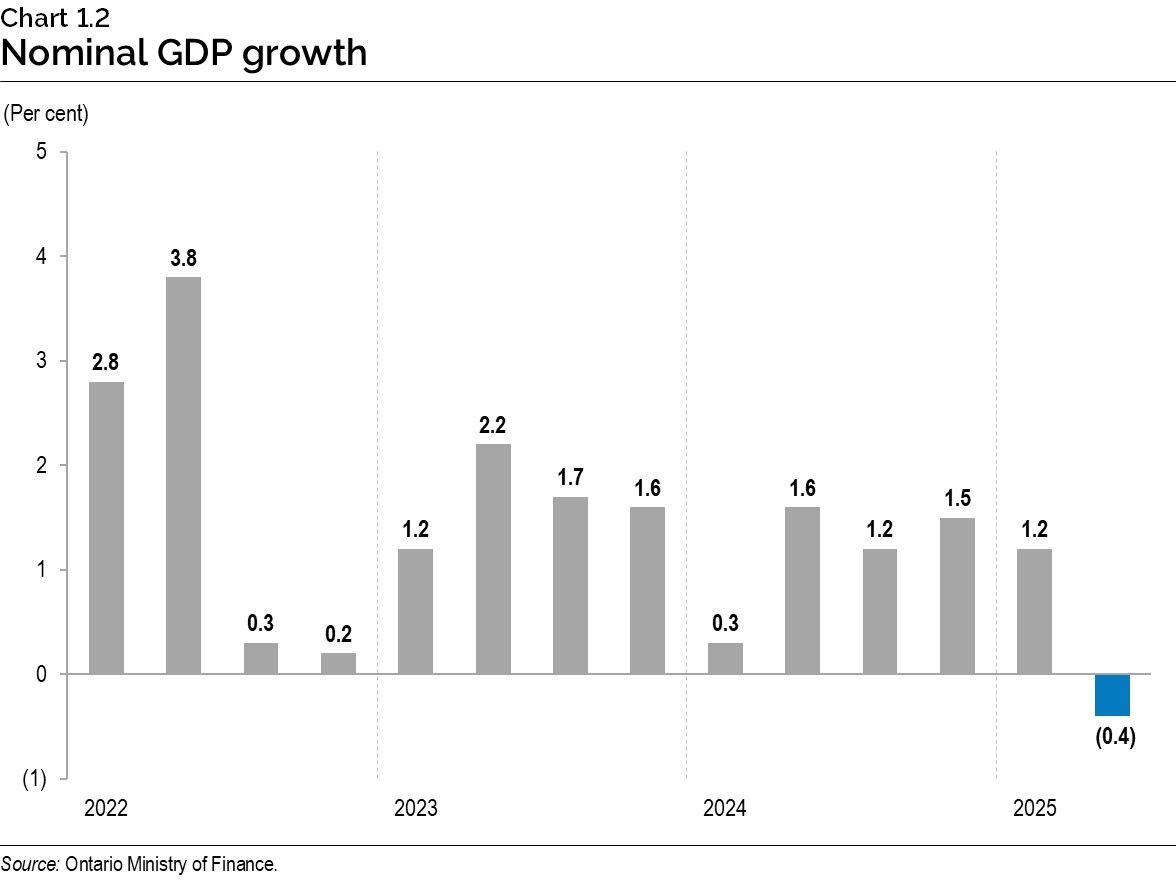
Compensation of employees, which includes both wages and salaries and supplementary labour income, edged up 0.1%, after rising 0.5% in the first quarter.
Net operating surplus of corporations decreased 2.1%, following a 0.4% increase in the previous quarter.
Net mixed income, which is comprised of farm income, unincorporated business income and rental income, increased 1.0%, following a 0.4% decline in the previous quarter.
| Component | 2023 | 2024 | 2024 Q3 | 2024 Q4 | 2025 Q1 | 2025 Q2 |
|---|---|---|---|---|---|---|
| Nominal GDP | 5.4 | 5.3 | 1.2 | 1.5 | 1.2 | (0.4) |
| Compensation of employees | 6.7 | 6.2 | 1.6 | 1.2 | 0.5 | 0.1 |
| Net operating surplus | (4.2) | (0.9) | (2.4) | 6.4 | 0.4 | (2.1) |
| Net mixed income | 11.5 | 13.1 | 2.9 | 2.6 | (0.4) | 1.0 |
Sources: Statistics Canada and Ontario Ministry of Finance.
Price details
Economy-wide prices, as measured by the implicit price index for GDP, increased 0.3% in the second quarter, following a 0.6% increase in the first quarter.
Prices for household consumption expenditures rose 0.2%, following a 0.5% increase in the first quarter.
Business investment prices increased 0.2%, following an increase of 1.0% in the previous quarter. Prices in the quarter increased for non-residential construction (+2.4%) and decreased for machinery and equipment (‑1.2%), intellectual property products (−0.3%) and residential construction (−0.1%).
Export prices (−0.8%) and import prices (−1.7%) both declined in the quarter.
| Component | 2023 | 2024 | 2024 Q3 | 2024 Q4 | 2025 Q1 | 2025 Q2 |
|---|---|---|---|---|---|---|
| GDP | 3.7 | 3.8 | 0.8 | 0.9 | 0.6 | 0.3 |
| Household consumption | 3.6 | 2.8 | 0.4 | 0.7 | 0.5 | 0.2 |
| Business investment | 3.4 | 1.7 | 0.7 | 0.9 | 1.0 | 0.2 |
| Exports | 3.5 | 3.2 | 0.5 | 1.6 | 1.5 | (0.8) |
| Imports | 1.5 | 2.2 | 0.6 | 1.4 | 2.6 | (1.7) |
Sources: Statistics Canada and Ontario Ministry of Finance.
Industry details
Ontario real GDP, measured as value-added by industry, declined 0.3% in the second quarter of 2025. Service sector output advanced 0.1% in the quarter, while output in the goods sector declined 1.4%.
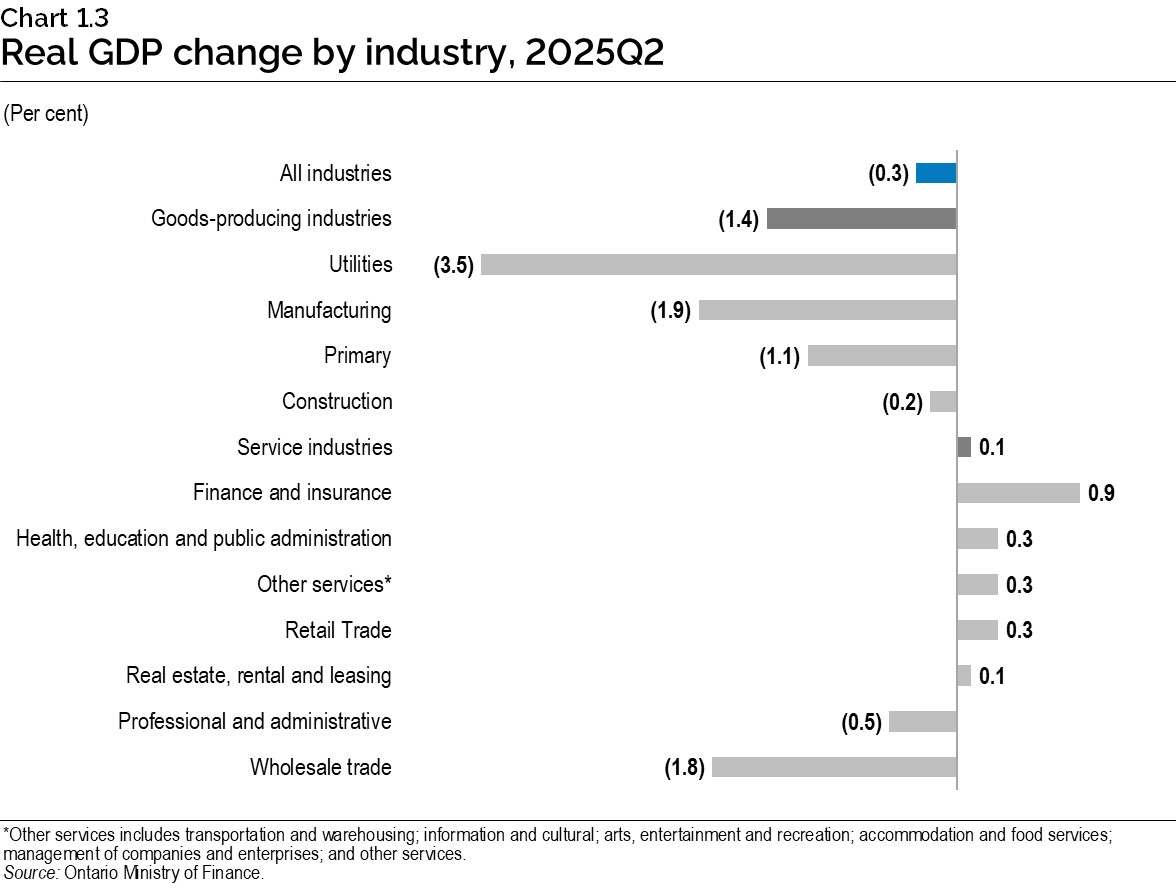
Manufacturing output decreased 1.9% in the second quarter, following an increase of 1.0% in the previous quarter.
Construction output decreased 0.2%, due to a decline in non-residential structures and engineering construction (−0.8%). Residential construction output increased 0.8% in the quarter.
Primary industry output declined 1.1%, as agriculture (−1.2%) and mining production (−0.9%) both declined in the quarter.
Utilities output declined 3.5%, following a 1.7% increase in the previous quarter.
Service industry output increased 0.1% in the quarter, led by gains in finance and insurance (+0.9%) and health, education, and public administration (+0.3%). Wholesale trade output declined 1.8% in the quarter.
| Component | 2023 | 2024 | 2024 Q3 | 2024 Q4 | 2025 Q1 | 2025 Q2 |
|---|---|---|---|---|---|---|
| Total output | 1.8 | 1.2 | 0.1 | 0.4 | 0.5 | (0.3) |
| Total goods producing industries | (0.3) | (2.3) | (0.7) | 0.4 | 0.3 | (1.4) |
| Primary | 1.8 | 2.9 | 0.2 | 0.0 | (0.1) | (1.1) |
| Utilities | 2.0 | 3.0 | 3.9 | (0.8) | 1.7 | (3.5) |
| Construction | (2.0) | (2.0) | (0.8) | 2.0 | (1.1) | (0.2) |
| Manufacturing | 0.1 | (4.7) | (1.8) | (0.5) | 1.0 | (1.9) |
| Total service producing industries | 2.4 | 2.3 | 0.3 | 0.4 | 0.5 | 0.1 |
| Wholesale trade | 1.4 | 0.8 | 0.8 | 2.2 | 1.0 | (1.8) |
| Retail trade | (0.2) | 1.3 | 0.7 | 2.3 | 0.9 | 0.3 |
| Transportation and warehousing | 8.9 | 3.1 | (0.6) | (0.2) | (0.4) | 0.2 |
| Information and culture | 1.3 | (0.2) | (2.6) | (2.0) | 1.3 | 0.1 |
| Finance and insurance | (0.2) | 3.6 | 1.7 | 0.6 | 0.9 | 0.9 |
| Real estate, rental and leasing | 0.4 | 2.8 | 1.0 | 1.5 | (0.3) | 0.1 |
| Management of companies and enterprises | (34.9) | (29.0) | (5.8) | (9.9) | (11.3) | (9.6) |
| Professional and administrative services | 3.2 | 0.9 | (0.4) | (0.8) | 0.4 | (0.5) |
| Education | 3.6 | 4.8 | 0.5 | (1.1) | 0.4 | (0.6) |
| Health care and social services | 4.1 | 3.3 | 0.1 | 0.5 | 0.5 | 0.4 |
| Arts, entertainment and recreation | 14.8 | 3.7 | 0.6 | 0.5 | 0.9 | 1.9 |
| Accommodation and food | 6.4 | 1.6 | (1.7) | 0.8 | 1.2 | 1.0 |
| Other services | 3.8 | 0.6 | (0.7) | (0.8) | 0.2 | (0.2) |
| Public administration | 3.3 | 2.7 | 1.0 | 0.4 | 0.7 | 0.9 |
Sources: Statistics Canada and Ontario Ministry of Finance.
Jurisdictional comparison
Canadian real GDP declined 0.4% in the second quarter, following a 0.5% increase in the previous quarter. The decrease in the second quarter was driven by a decrease in goods exports and machinery and equipment investment. The overall decline was moderated by an increase household spending and inventory accumulation, as well as lower imports of goods.
Quebec’s real GDP declined 0.6% in the second quarter, following a 0.4% gain in the previous quarter. The decline was primarily driven by a decrease in exports. Gains in household consumption and faster inventory accumulation moderated the overall decline.
In the U.S., real GDP advanced 0.9% in the second quarter, following a decline of 0.2% in the previous quarter. The increase in the second quarter was driven by a decrease in imports and an increase in consumer spending. This was partially offset by declines in investment and exports.
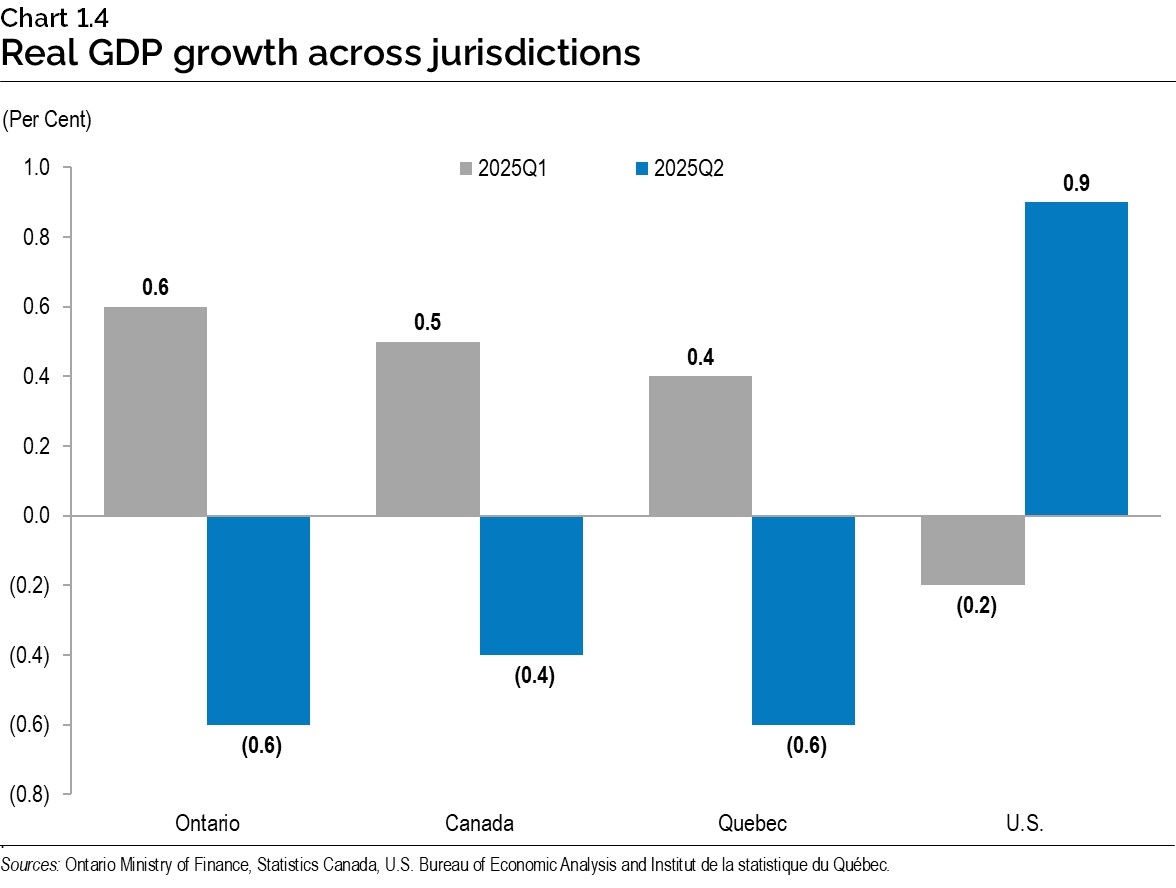
Global economic environment
Real GDP in the U.S. increased by 0.9% in the second quarter of 2025, following a decrease of 0.2% in the first quarter. The second quarter increase primarily reflected a decrease in imports and an increase in consumer spending but was partly offset by decreases in investment and exports.
Euro area real GDP grew 0.1% in the second quarter, down from a 0.6% increase in the first quarter. Growth in the second quarter was led by government final expenditure and household consumption, while gross fixed capital investment and net exports decreased.
U.K. real GDP grew 0.3% in the second quarter, following a 0.7% increase in the first quarter. Growth in the second quarter was driven by increases in services and construction.
Real GDP growth in Japan increased by 0.5% in the second quarter, rising from 0.1% growth in the first quarter. China’s real GDP increased by 1.1% in the second quarter of 2025, moderating from growth of 1.2% in the first quarter.
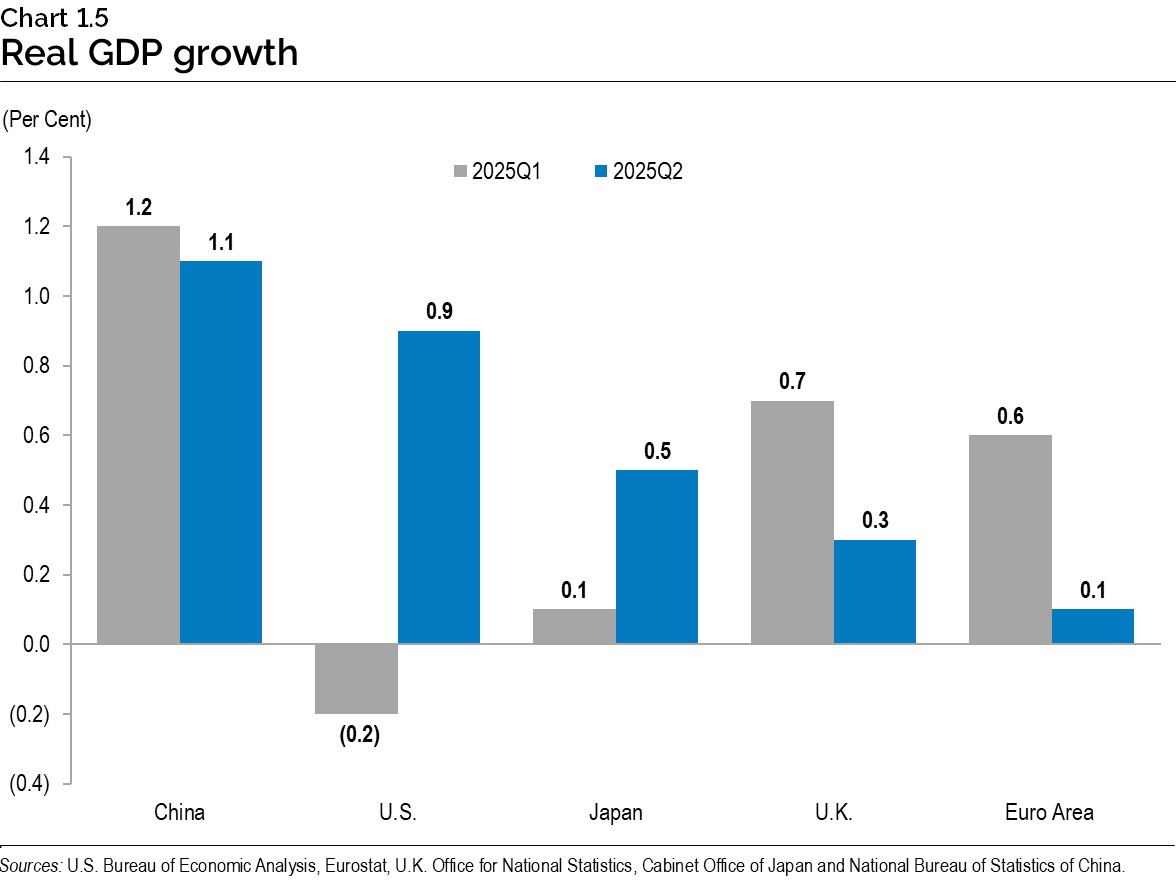
At the September monetary policy meeting, the Bank of Canada lowered the overnight rate target to 2.50% after leaving the rate unchanged at 2.75% at its July monetary policy meeting. The Bank assessed that the rate reduction was warranted due to a weaker economy along with less upside risk to inflation. The Bank noted that disruptive effects from trade shifts will weigh on economic activity and raise costs. Since June 2024, the Bank of Canada has reduced its policy interest rate by a total of 250 basis points.
The U.S. Federal Reserve reduced its target range for the federal funds rate to 4.00-4.25% at the September monetary policy meeting. The target range had previously been unchanged since December 2024. The Federal Reserve noted that despite rising inflation, downsides to employment have risen as the unemployment rate has increased and job gains have eased. Since September 2024, the Federal Reserve has reduced its key policy interest rate target by a total of 125 basis points.
The yield on short-term Canadian government bonds were little changed in the third quarter of 2025. The Canadian 3-month government treasury bill yield averaged 2.6% in the third quarter, compared to 2.7% in the second quarter. The yield on the Canadian 10-year government bond edged up to 3.4% in the third quarter from 3.2% in the second quarter.
The U.S. dollar remained little changed in the third quarter as uncertainty around U.S. trade policy eased somewhat compared to earlier in the year. The Canadian dollar strengthened to 72.6 cents US in the third quarter of 2025, up from 72.3 cents US in the second quarter.
Oil prices increased modestly amid rising oil inventories and stabilizing global economic growth prospects. The West Texas Intermediate (WTI) crude oil price averaged US$66 per barrel in the third quarter of 2025, up slightly from US$65 per barrel in the second quarter.
| Component | 2023 | 2024 | 2024 Q3 | 2024 Q4 | 2025 Q1 | 2025 Q2 | 2025 Q3 |
|---|---|---|---|---|---|---|---|
| U.S. real GDP growth (per cent) | 2.9 | 2.8 | 0.8 | 0.6 | (0.1) | 0.8 | – |
| West Texas Intermediate (WTI) crude oil ($US per barrel) | 78 | 77 | 76 | 71 | 72 | 65 | 66 |
| Canadian dollar (cents US) | 74.1 | 73.0 | 73.3 | 71.5 | 69.7 | 72.3 | 72.6 |
| Three-month treasury bill rate1 (per cent) | 4.8 | 4.3 | 4.2 | 3.4 | 2.8 | 2.7 | 2.6 |
| 10-year government bond rate (per cent) | 3.3 | 3.4 | 3.1 | 3.3 | 3.1 | 3.2 | 3.4 |
[1] Government of Canada interest rates.
Sources: U.S. Bureau of Economic Analysis; U.S. Energy Information Administration, and Bank of Canada.
Appendix A: OEA release dates
The Fiscal Sustainability, Transparency and Accountability Act, 2019 states that the quarterly Ontario Economic Accounts should be released within 45 days of the Statistics Canada release of the National Income and Expenditure Accounts.
In compliance with the legislation, the OEA will be released according to the following schedule:
| Reference Period | Expected Statistics Canada release of National Income and Expenditure Accounts | Corresponding deadline for the release of Ontario Economic Accounts |
|---|---|---|
| Third quarter (July-September) 2025 | November 28, 2025 | By January 12, 2026 |
| Fourth quarter (October-December) 2025 | February 27, 2026 | By April 13, 2026 |
Appendix B: Structure of the Ontario economy
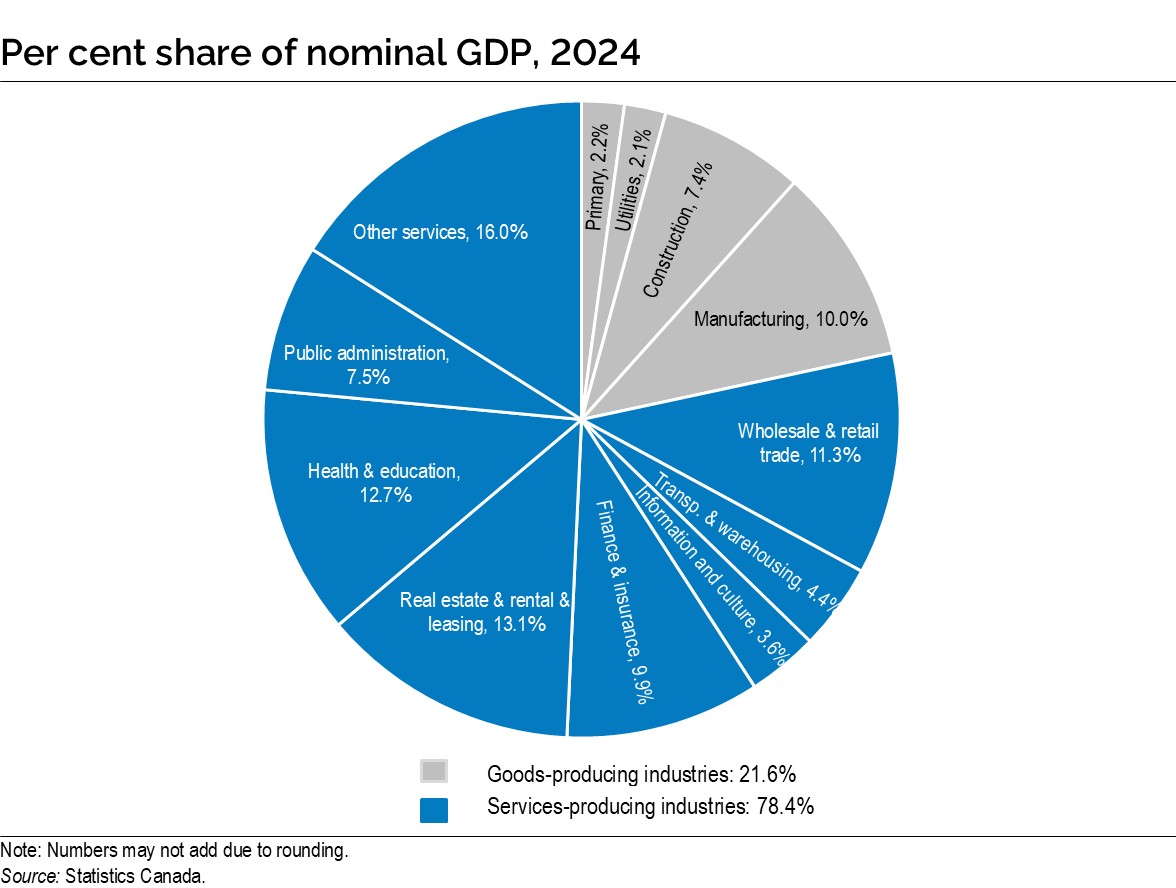
Appendix C: How GDP is measured
The Ontario Economic Accounts provide measurements of GDP using three different methodologies, by expenditure, income and industry.
The GDP by expenditure approach defines GDP as the aggregate of all expenditures on final consumption, gross capital formation and net trade by consumers, governments and businesses that occur within Ontario’s economy over a given time period. This measurement of GDP can also be defined as the sum of consumer spending, gross investment, government spending and net trade.
The GDP by income approach equates GDP to the total income earned through contributions to production within Ontario’s economy by labour and capital over a given time period. That is, GDP is the sum of all wages and salaries paid to employees, the gross operating surplus of businesses, gross mixed income and indirect taxes less subsidies.
The GDP by industry approach measures GDP by calculating the total output of the goods and services producing industries within Ontario’s economy and subtracting the cost of intermediate inputs used in final production. This approach can also be referred to as the value-added approach as it quantifies the additional value generated by industries through the production of final products within the economy.
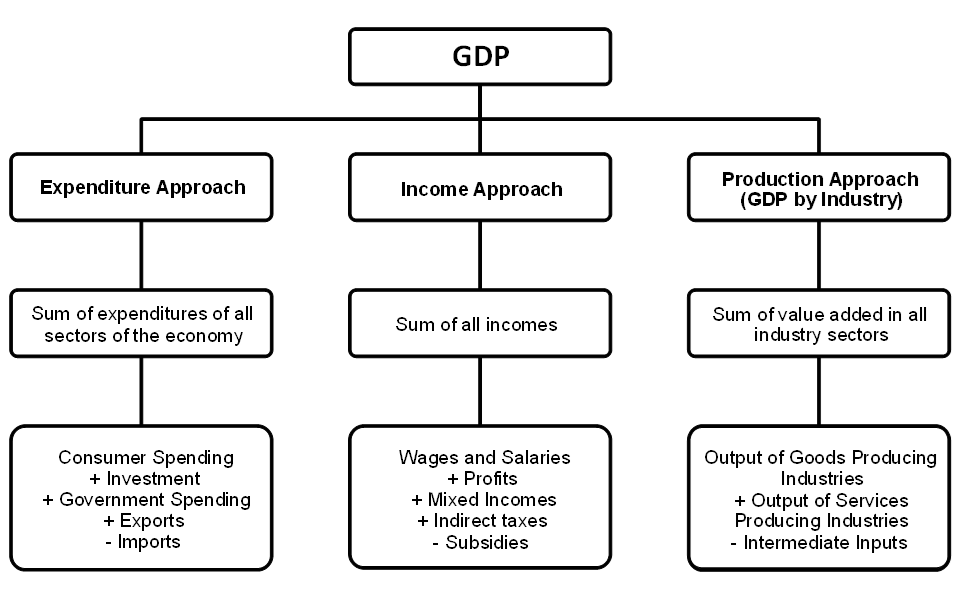
For a full list of definitions used in the Ontario Economic Accounts, please see Statistics Canada’s System of Macroeconomic Accounts Glossary at https://www150.statcan.gc.ca/n1/pub/13-605-x/gloss/gloss-a-eng.htm.
Accessible chart descriptions
Chart 1.1: Real GDP growth
The bar chart illustrates Ontario’s quarterly per cent real GDP growth from the first quarter of 2022 to the second quarter of 2025. In the four quarters of 2022, real GDP growth was 1.1%, 0.9%, 0.3% and -0.2%, respectively. In the four quarters of 2023, real GDP growth was 1.0%, 0.4%, 0.3% and 0.2%, respectively. In the four quarters of 2024, real GDP growth was 0.3%, 0.4%, 0.4% and 0.6%, respectively. In the first quarter of 2025, real GDP increased 0.6% and in the second quarter declined 0.6%.
Source: Ontario Ministry of Finance.
Chart 1.2: Nominal GDP growth
The bar chart illustrates Ontario’s quarterly per cent nominal GDP growth from the first quarter of 2022 to the second quarter of 2025. In the four quarters of 2022, GDP growth was 2.8%, 3.8%, 0.3% and 0.2%, respectively. In the four quarters of 2023, GDP growth was 1.2%, 2.2%, 1.7% and 1.6%, respectively. In the four quarters of 2024, GDP growth was 0.3%, 1.6%, 1.2% and 1.5%, respectively. In the first quarter of 2025, GDP increased 1.2% and in the second quarter declined 0.4%.
Source: Ontario Ministry of Finance.
Chart 1.3: Real GDP Change by Industry, 2025 Q2
The horizontal bar chart illustrates the per cent change in real GDP by industry for the second quarter of 2025. The output of all industries declined 0.3% in the quarter. Output decreased in goods-producing industries (−1.4%), with industry changes as follows: utilities (−3.5%); manufacturing (−1.9%); primary (−1.1%); and construction (−0.2%). Output in the service industries increased 0.1%, including industry changes as follows: finance and insurance (+0.9%); health, education and public administration (+0.3%); other services* (+0.3%); retail trade (+0.3%); real estate, rental and leasing (+0.1%); professional and administrative services (−0.5%); and wholesale trade (−1.8%).
*Other services include transportation and warehousing; information and cultural; arts, entertainment, and recreation; accommodation and food services; management of companies and enterprises; and other services.
Source: Ontario Ministry of Finance.
Chart 1.4: Real GDP growth across jurisdictions
This bar chart shows quarterly percentage changes in real GDP for Ontario, Canada, Quebec and the U.S. for the first quarter of 2025 and second quarter of 2025. Ontario real GDP increased 0.6% in the first quarter and declined 0.6% in the second quarter. Canadian real GDP increased 0.5% in the first quarter and declined 0.4% in the second quarter. Quebec real GDP increased 0.4% in the first quarter and declined 0.6% in the second quarter. U.S. real GDP declined 0.2% in the first quarter and increased 0.9% in the second quarter.
Sources: Ontario Ministry of Finance, Statistics Canada, U.S. Bureau of Economic Analysis and Institut de la statistique du Québec.
Chart 1.5: Real GDP growth
This bar chart shows quarterly percentage changes in real GDP for China, the U.S., Japan, the United Kingdom and the euro area for the first quarter of 2025 and second quarter of 2025. China’s real GDP increased 1.2% in the first quarter and 1.1% in the second quarter. U.S. real GDP declined 0.2% in the first quarter and increased 0.9% in the second quarter. Japan’s real GDP increased 0.1% in the first quarter and increased 0.5% in the second quarter. Real GDP in the United Kingdom increased 0.7% in the first quarter and 0.3% in the second quarter. Euro area real GDP increased 0.6% in the first quarter and 0.1% in the second quarter.
Sources: U.S. Bureau of Economic Analysis, Eurostat, U.K. Office for National Statistics, Cabinet Office of Japan, and National Bureau of Statistics of China.
Chart: Appendix B, Per Cent Share of Nominal GDP, 2024
This pie chart shows the percent share of nominal GDP by industry for 2024. Goods-producing industries accounted for 21.6% of Ontario’s nominal GDP with industry shares as follows: manufacturing (10.0%); construction (7.4%); utilities (2.1%) and primary industries (2.2%). Services-producing industries accounted for 78.4% of Ontario’s nominal GDP with industry shares as follows: wholesale and retail trade (11.3%); transportation and warehousing (4.4%); information and culture (3.6%); finance and insurance (9.9%); real estate, rental and leasing (13.1%); health and education (12.7%); public administration (7.5%); and other services (16.0%).
Note: Numbers may not add due to rounding.
Source: Statistics Canada.
Chart : Appendix C, GDP measurement methods
- Expenditure Approach
- Sum of expenditures of all sectors of the economy
- Consumer Spending + Investment + Government Spending + Exports – Imports
- Income Approach
- Sum of all incomes
- Wage and Salaries + Profits + Mixed Incomes + Indirect taxes – Subsidies
- Production Approach (GDP by Industry)
- Sum of value added in all industry sectors
- Output of Goods Producing Industries + Output of Services Producing Industries – Intermediate Inputs